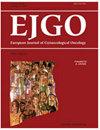Tumor proximity to serosal surface as an independent prognostic factor in FIGO stage 1 endometrial cancer
IF 0.5
4区 医学
Q4 OBSTETRICS & GYNECOLOGY
引用次数: 0
Abstract
Objective: Determine if tumor distance from serosal surface is an independent prognostic factor for disease recurrence and survival in stage 1 endometrial cancer. Methods: 747 patients diagnosed with stage 1 endometrial cancer between 1984 and 2015 were identified from an institutional database. This retrospective cohort was evaluated to assess di ferences in tumor distance from the serosal surface, histologic subtype, histologic grade, use of adjuvant treatment, recurrence rates and overall survival. Cox proportional hazard models were used to determine if variables of interest were related to recurrence and overall survival. Concordance correlation coe ficients were used to compare our model to the 2009 International Federation of Gynecology andObstetrics (FIGO) staging. Results: Tumor distance from serosal surface ranged from 0mm–21mm. 47 (8.7%) patients experienced recurrence. Patients with tumors located 5mmor less from the serosal surface were 2.24 times more likely to experience recurrent disease (HR 2.24, 95% CI: 1.16 to 4.31, p = 0.02). Concordance rates for disease recurrence were 0.573 and 0.583 for our tumor distance model compared to the 2009 FIGO staging (95% CI: 0.568 to 0.579 and 95% CI: 0.577 to 0.589). Conclusions: Our study demonstrates that patients with tumors located 5 mm or less from the serosal surface have a two-fold increased risk of recurrence. Concordance ratesarevery similarbetweenourmodelandthe2009FIGO staging suggesting comparable predictability; these rates suggest there is roomfor improvement inbothmethods topredict disease recurrence and survival.肿瘤靠近浆膜表面是FIGO 1期癌症的独立预后因素
目的:确定肿瘤与浆膜表面的距离是否是癌症1期疾病复发和生存的独立预后因素。方法:从机构数据库中确定1984年至2015年间诊断为癌症1期的747名患者。对该回顾性队列进行评估,以评估肿瘤与浆膜表面的距离、组织学亚型、组织学分级、辅助治疗的使用、复发率和总生存率的差异。Cox比例风险模型用于确定感兴趣的变量是否与复发和总生存率有关。使用一致性相关系数将我们的模型与2009年国际妇产科联合会(FIGO)的分期进行比较。结果:肿瘤距浆膜表面的距离为0~21mm。复发47例(8.7%)。肿瘤位于浆膜表面5毫米以下的患者复发疾病的可能性是其他患者的2.24倍(HR2.24,95%CI:1.16至4.31,p=0.02)。与2009年FIGO分期相比,我们的肿瘤距离模型的疾病复发符合率分别为0.573和0.583(95%CI:0.568至0.579,95%CI:0.577至0.589)。结论:我们的研究表明距离浆膜表面5mm或更小的肿瘤复发的风险增加了两倍。协和率与2009年FIGO分期之间几乎相似,这表明可预测性相当;这些发病率表明,在预测疾病复发和生存率的方法上还有改进的空间。
本文章由计算机程序翻译,如有差异,请以英文原文为准。
求助全文
约1分钟内获得全文
求助全文
来源期刊
自引率
25.00%
发文量
58
审稿时长
1 months
期刊介绍:
EJGO is dedicated to publishing editorial articles in the Distinguished Expert Series and original research papers, case reports, letters to the Editor, book reviews, and newsletters. The Journal was founded in 1980 the second gynaecologic oncology hyperspecialization Journal in the world. Its aim is the diffusion of scientific, clinical and practical progress, and knowledge in female neoplastic diseases in an interdisciplinary approach among gynaecologists, oncologists, radiotherapists, surgeons, chemotherapists, pathologists, epidemiologists, and so on.

 求助内容:
求助内容: 应助结果提醒方式:
应助结果提醒方式:


